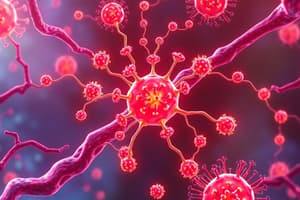Podcast
Questions and Answers
What role does C5a play in the complement system?
What role does C5a play in the complement system?
- It forms part of the MAC assembly complex.
- It directly lyses bacterial cells.
- It recruits and activates immune cells. (correct)
- It binds to microbial cells for opsonization.
What mechanism allows the complement system to avoid attacking host cells?
What mechanism allows the complement system to avoid attacking host cells?
- Utilization of alternative pathways to target only pathogens.
- Continuous secretion of C3b to tag foreign cells.
- Production of antibodies against complement proteins.
- Presence of specific receptors that inhibit the complement cascade. (correct)
What initiates the formation of the Membrane Attack Complex (MAC)?
What initiates the formation of the Membrane Attack Complex (MAC)?
- C9 polymerizes into large clusters.
- C5b binds to C6, C7, and C8. (correct)
- C3b attaches to cell membranes.
- C5a recruits C3 convertase to the membrane.
How does C3b contribute to the process of opsonization?
How does C3b contribute to the process of opsonization?
What is a key outcome of the complement activation on bacterial membranes?
What is a key outcome of the complement activation on bacterial membranes?
Which component in the classical pathway begins the activation of complement?
Which component in the classical pathway begins the activation of complement?
What is the result of C1s cleaving C4 in the classical pathway?
What is the result of C1s cleaving C4 in the classical pathway?
What initiates the lectin pathway of complement activation?
What initiates the lectin pathway of complement activation?
In the alternative pathway, how is C3(H2O) activated?
In the alternative pathway, how is C3(H2O) activated?
What complex forms the initial C3 convertase in the alternative pathway?
What complex forms the initial C3 convertase in the alternative pathway?
The formation of C5 convertase in the alternative pathway includes which components?
The formation of C5 convertase in the alternative pathway includes which components?
Which component does mannose binding lectin primarily bind to for initiation of the lectin pathway?
Which component does mannose binding lectin primarily bind to for initiation of the lectin pathway?
Which of the following statements is true regarding the roles of the complement system?
Which of the following statements is true regarding the roles of the complement system?
Flashcards
C3b
C3b
A molecule that covalently attaches to microbial cells via high reactive thioester bond.
C5 convertase
C5 convertase
An enzyme complex (C4b2aC3b) that cleaves C5 into C5a and C5b.
C5a
C5a
A powerful anaphylatoxin that recruits and activates immune cells.
MAC assembly
MAC assembly
Signup and view all the flashcards
Complement inhibitors
Complement inhibitors
Signup and view all the flashcards
Complement System
Complement System
Signup and view all the flashcards
Roles of Complement
Roles of Complement
Signup and view all the flashcards
Classical Pathway
Classical Pathway
Signup and view all the flashcards
Lectin Pathway
Lectin Pathway
Signup and view all the flashcards
Alternative Pathway
Alternative Pathway
Signup and view all the flashcards
Membrane Attack Complex (MAC)
Membrane Attack Complex (MAC)
Signup and view all the flashcards
Study Notes
Complement System Overview
- Part of the innate immune system
- Found in blood plasma
- Produced in the liver
Roles of Complement
- Killing (lysis) of foreign cells
- Tagging foreign material (opsonization)
- Pro-inflammatory signalling and chemoattraction
Complement Pathways
- All pathways converge to form C3 convertase and the membrane attack complex (MAC)
Classical Pathway
- Initiated by antibody binding
- C1 Complex: Composed of C1q, C1r, and C1s. C1q binds to the Fc region of antibodies.
- Activation: Binding of two or more antibodies to antigen activates C1r and C1s. C1r cleaves C1s, which in turn cleaves C4 and C2.
- C4b binds to the bacterial surface; C2a and C2b are formed.
- C4b and C2a combine to form the classical C3 convertase (C4b2a).
Lectin Pathway
- Initiated by a lectin (e.g., mannose-binding lectin (MBL))
- MBL binds to carbohydrates, specifically mannose, on the surface of bacteria and yeast.
- MBL-associated serine protease (MASP) cleaves C4 and C2, forming the C3 convertase (C4b2a).
Alternative Pathway
- Does not require antibody or microbe to initiate
- C3 is hydrolyzed to C3(H2O)
- C3(H2O) binds to Factor B, then Factor D cleaves Factor B into Bb and Ba fragments.
- C3bBb (initial convertase) binds to C3, forming C3bBbC3b (C3 convertase)
- C3b covalently attaches to the microbial surface activating an amplification loop.
Terminal Complement Pathway
- Formation of C5 convertase:
- From the alternative pathway: C3bBb and another C3b form C3bBbC3b (C5 convertase).
- From the lectin/classical pathway: C4b2a and another C3b form C4b2aC3b (C5 convertase).
- C5 cleavage: C5 convertase cleaves C5 into C5a and C5b.
- C5a: A powerful anaphylatoxin that recruits and activates immune cells.
- C5b: Initiates the membrane attack complex (MAC) formation.
- MAC Assembly: C5b recruits C6, C7, C8, and multiple C9 molecules to form a transmembrane pore in the microbial membrane.
- Bacterial Death: MAC forms pores in the microbial membrane, leading to leakage of cytoplasmic contents, bacterial lysis, and cell wall instability.
Complement Function
- Opsonization: C3b and C4b tag microbes, serving as opsonins for recognition by phagocytes.
- Inflammation: Cleaved 'a' products (e.g., C3a, C4a, C5a) are anaphylatoxins that bind to receptors on immune cells, triggering inflammation (chemotaxis, vasodilation, increased vascular permeability).
- Lysis: MAC formation leads to direct lysis of invading microbes.
Complement Regulation
- Preventing self-damage: Inhibitors prevent complement activation on host cells. Immune cells present complement regulatory proteins, preventing unintended damage to healthy tissue.
- Example: CD59 on mammalian cells inhibits C5b-C8 complex formation, preventing C9 recruitment.
- Consequences of deficiency: Individuals with terminal complement deficiencies are at increased risk of recurrent infections.
Studying That Suits You
Use AI to generate personalized quizzes and flashcards to suit your learning preferences.



![Lecture 04: The Complement System and Pathways in Immunology {MCQ 1]](https://assets.quizgecko.com/cdn-cgi/image/width=300,height=200,fit=crop,quality=75,format=webp/quiz/0c9d7db8e7a538eb3326d8a833db6ee5.jpg)